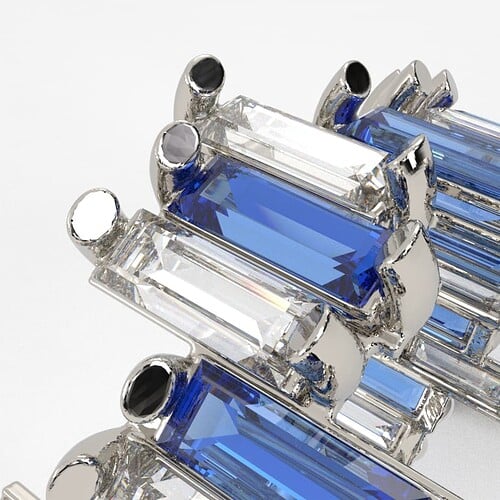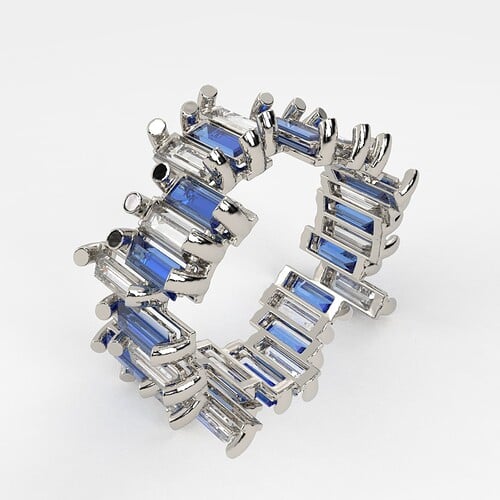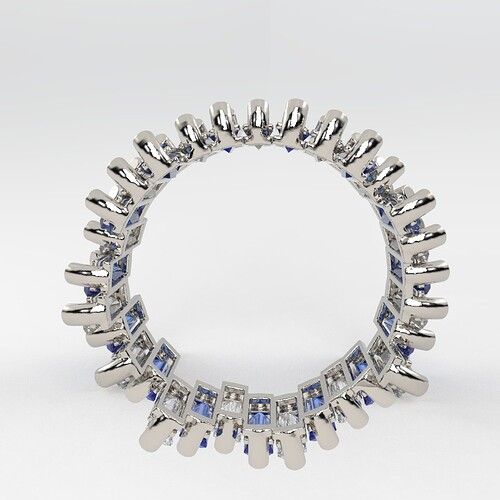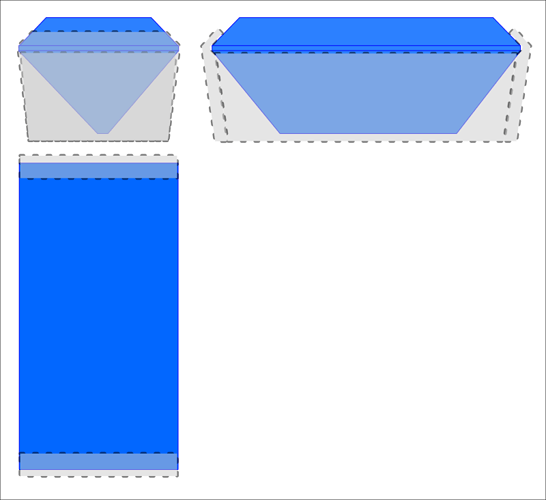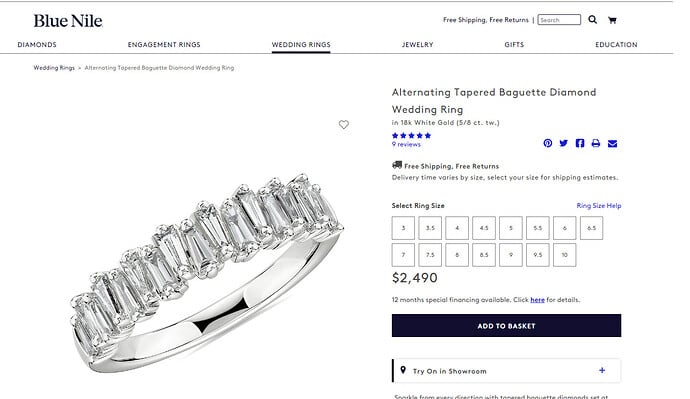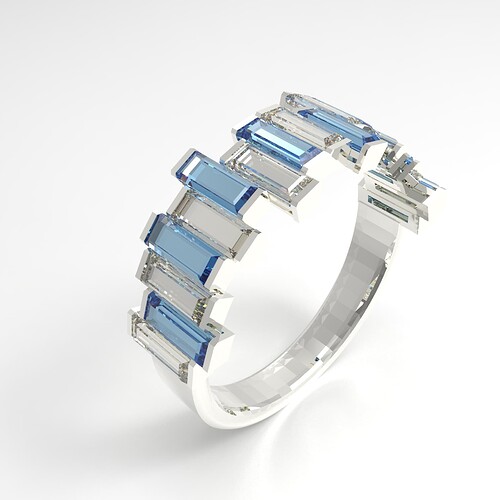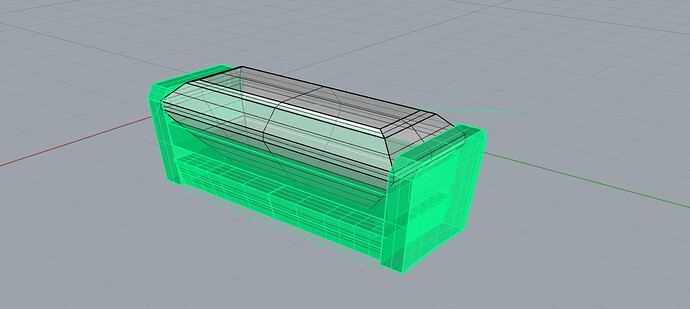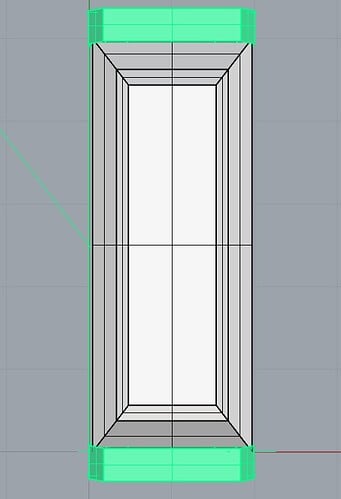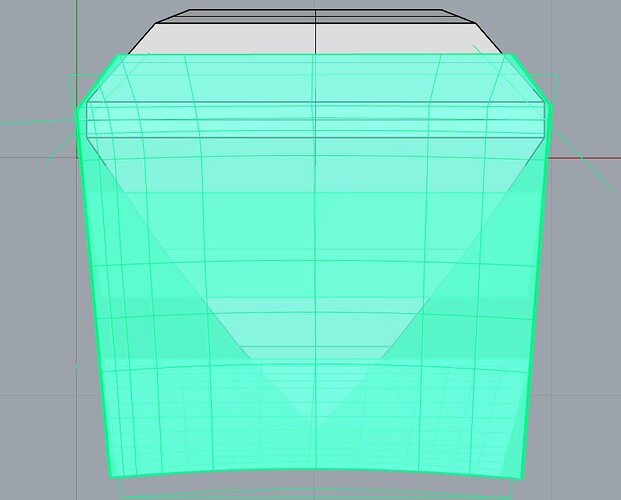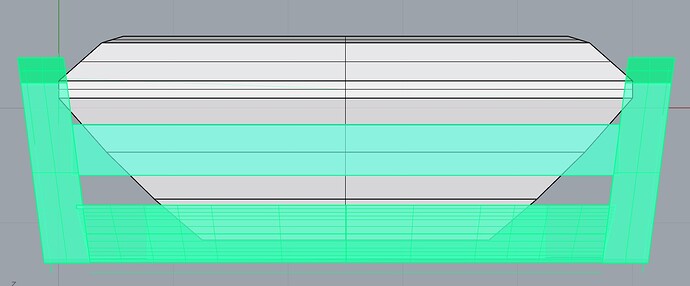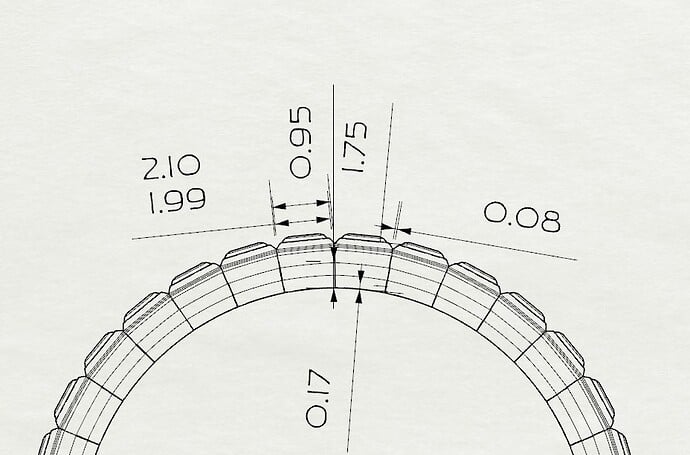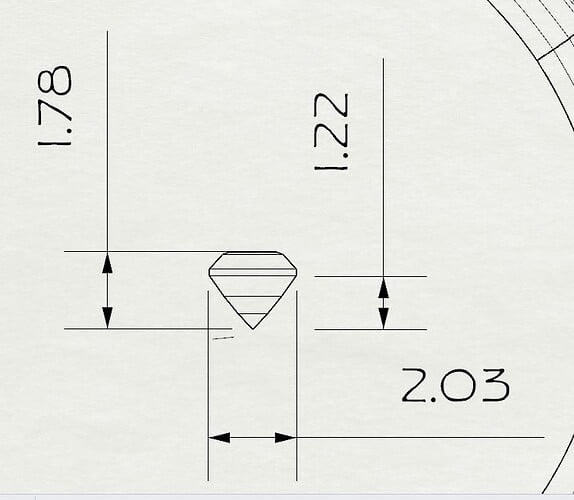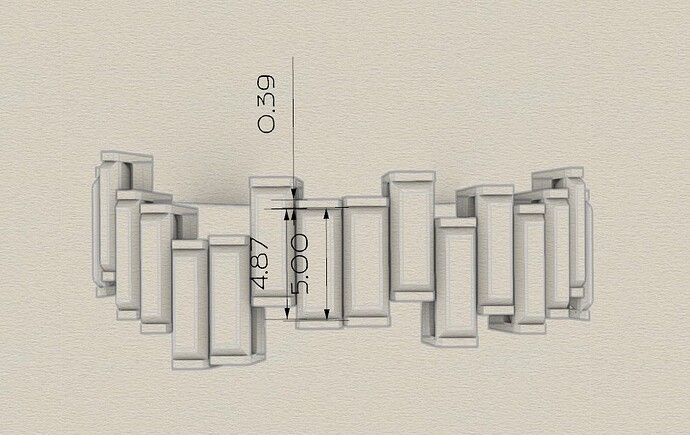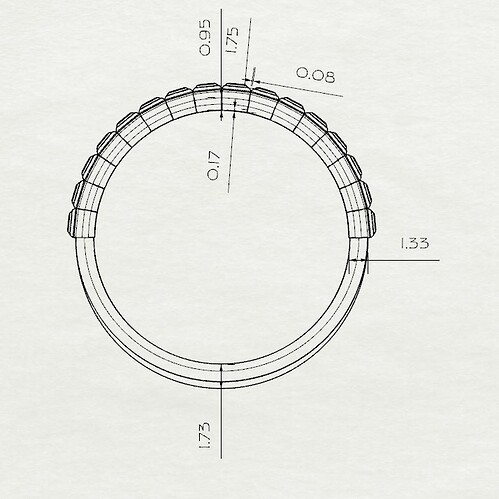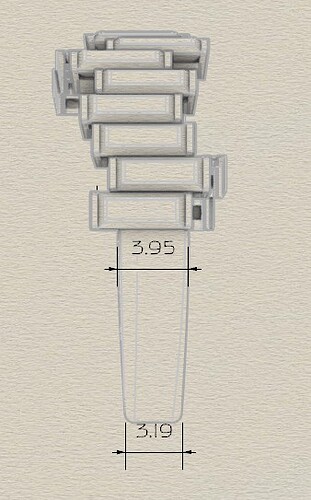Hello, would you please critique my proposed baguette setting and design? It seems sharp, but I think the setter will be able to round the large prongs down once it is in place?
Don’t mind the stones poking through. The stones were a little misaligned in the rendering.
Hi Steve,
My suggestion is…rather than round prongs on the outside, perhaps more of a “bar” setting…i feel like it would lend itself to the shape of the elongated rectangular baguette…and oerhaps be less likely to catch and become loose…
here is a link to an example…
https://mdcdiamonds.com/WedAndetails.cfm?Stock=WB445&Country=US
julie
Hi Steve,
I sure wish I had your CAD skills!
There are reasons for the traditional ways of doing things, including setting baguettes. One reason they are set with the “bars” that Julie is talking about is an esthetic one…maybe not everyone agrees, but many folks would say that a baguette set this way just looks better than one set with a very large single prong. Another reason would be to protect the corners of the baguette, which otherwise could easily chip. Also, in your design, you have left a lot of prong to be ground off and this wastes metal. I think rather than inventing settings out of your head, it would help to look at how they are usually done beforehand. This is not to say that you would never decide to do things differently, just that you would know the traditional ways of doing things before you decide to consciously depart from them. -royjohn
Also, in the rendering the boxes are too large which makes the stones sit too far apart and shows the edges of the girdle bezel between the stones.
In classical high jewelry the focus is on the stones. The setting should be as minimal as possible, while still being secure, so that little metal shows from the front.
Now, if it is your intention to show a large amount of metal around each baguette I suggest beefing up the boxes even more. Now it just looks like the stones were fitted poorly.
Does Gerry have a sheet on setting baguettes?
Here’s a quick diagram. In the case of a ring you want the long sides of the box to slope inward to allow for the angle between each setting. This can either be done in the initial construction or by filing while setting up. Or in CAD, obviously.
My two cents is that the hollow prongs won’t work: they will be thin walled and if you want that look set a round black disk in it. But the setting overpowers the stones, really. Also they will fill up with lotion etc and have a less clean look to them. Go with the bars. You are doing a good job in sticking to it; have you gone through magazines like: Professional Jeweler, AJM, and others? Also, instagram is a great place to see lots of different styles. Don’t be afraid to check out jewelers in Germany and other places. It’s a big tent of many different styles of metalwork. Keep at it.
What Julie, Royjohn and Elliot said.
It’s not just for aesthetics. It’s a wearability and an engineering issue too.
First the engineering.
It is crucial that on a ring the heaviest part of a mounting with stones be the support area underneath the stones. Why? Because when wearing a ring the actions that hands do during every day life will put impacts and stressors on the mounting. Thus causing it to bend in the thinest areas. If that is underneath the stones the seats that the stones are sitting on will bend first thus shifting the stones causing them to fall/pop out of the ring. When ever making a ring it is always crucial that the weakest point be away from the gems. Preferably at the bottom of the ring.
Also the sharp corners of the stones will be exposed. This is both an engineering and a wearability issue. As Royjohn pointed out, sharp corners on gems love to break off. And the hard sharp corners love to scratch and snag on both clothing and flesh.
As to wearability… Prongs that are 360 degrees around the mounting do a couple of things. They like to not only snag but they are very uncomfortable to wear. They tend to rub, gouge and irritate the the delicate skin on the sides of the adjoining fingers. Imagine trying to handle a baby, a cashmere sweater or a silk anything. In most of the custom and repair shops where I worked we always kept a silk tie or scarf on hand so that when the jobs left the final polishing they were rubbed against the silk. If there were any snags they got returned to the person how worked on it.
Square and rectangular shaped stones love to shift sideways when trying to set them with prongs. It’s such a pain in the ass to set them that way. Ya don’t want to piss off a professional stone setter. They are already cranky and can be prone to having hissy fits.
And finally…
Most pros try to discourage clients from buying eternity rings. First of all, many clients end up having their rings sized at some point in time. Thus the old jeweler’s joke “What is the difference between a fiancee and a spouse? About 20l bs.” Sizing an eternity ring is most bench jeweler’s worst night mare. Usually we recommend that the ring be returned to the original manufacturer. Also the stones and the metal holding them in that migrate towards the bottom of the ring facing the palm of the hand end up getting beat to s**t. Again loosing and breaking stones and needing to have the metal rebuilt where it has been gouged and worn away.
Engineering as well as manual labor sills are imperative when designing and making jewelry. Making beautiful things is just the icing on the cake.
-Jo
Jewelry, especially wedding/ engagement purchases are often the largest big ticket items that most folks make other than purchasing a car or a house. It’s important to make sure that these things last a long time.
Blue Nile is a mass seller of fashionable diamond jewelry. They are budget minded rather than quality minded. It’s what we call in the trade “A race to the bottom”. I would recommend that you search the web sites of classic high end makers like this https://www.cartier.com/en-us/high-jewelry/latest-collections/beautes-du-monde/ or this Fine Jewelry - Oscar Heyman Both have been in business for over 100 years.
The Blue Nile price is really low, so I’m betting that the mounting is very light weight and the diamonds really small. The total weight of the stones is 5/8ths of a carat. From the image I count about 17 stones. They would measure at their widest point 2.25mm wide by 1.5 mm, long. Since they are tapered to the narrow end the width would be super small and very prone to breakage and a pain in the ass to set. And as I said before, ya don’t want to piss of the stone setter.
Eternity bands were promoted by DeBeers back in the mid 20th century. They had a huge glut of small diamonds and needed to get rid of them. Thus the invention of the eternity ring was purely a Sales Tool. This falls under the old “It seemed like a good idea at the time.” It was roughly about the same time that DeBeers started the advertising campaign motto of “A Diamond is forever.” The motto stuck. Sadly the public now believes it also refers to diamonds and diamond jewelry. So whenever a piece of jewelry or the stones set within break or just wear out with time retail customers expect either a free replacement or a free repair. Leaving us makers and sellers with a Very unhappy and soon to be former client. These days their complaints aren’t just to their family and friends, but are also posted online forever so that a gazillion people for years to come decide to not patronize the maker. Also the unhappy customer if they have the resources may hire a Lawyer and try to take the case to court. And the only party that will benefit will be the Lawyer. They have enough money already:-) Though diamonds are really hard, they have perfect cleavage and can be broken. They are hard but not as tough as say a piece of jade. I tell folks that if you set a diamond and a jade side by side on the street and ran over them with a big steam roller the diamond would break but not scratch. The jade would scratch but not break.
You have good CAD skills, but if you want to make a career out of jewelry design you will really need to learn hands on how to make and fix the stuff. The best way to know how design well made and sturdy jewelry is to work in a repair trade shop. One learns from other craftsmen and designers mistakes rather than learning from one’s own mistakes that can be costly in both the short and the long term.
I am at best a mediocre stone setter. I hand off the complicated and difficult stone setting to an expert. However when I was learning the trade I did my best to learn the basics of stone setting so that I would know how to build pieces that would be easy for the setters. I’ve worked with setters who would literally throw a piece across the room at the metalsmith who made it. They tend to be the prima donnas of the jewelry world:-)
-Jo
Hi Steve,
I hate to continue to be negative, but when I enlarged this picture, it looked like the corners of the baguettes were covered by metal. It just looks like they are not because the weird-ass decorative beads (??) in the middle are so much higher that it looks like they are the only thing touching the stones. I don’t think this ring is very pretty, myself, but that’s just one opinion. -royjohn
Steve,
I’ve been hesitant to comment on this Design, as I don’t like to discourage anyone who’s starting out, but I would like to second Jo’s last response: “The best way to know how to design well made and sturdy jewelry is to work in a repair trade shop. One learns from other craftsmen and designers mistakes rather than learning from one’s own mistakes that can be costly in both the short and the long term.”, she is exactly right! I have Repaired countless pieces of low-end to mid-range Jewellery on up to some of the finest pieces made by the biggest names in the Jewellery Trade and there is a vast difference in quality, even just from the low-end to mid-range pieces. Many of the pieces that we most often see in Jewellery Stores, mall stores in particular and stores like Blue Nile (like the piece that you included above) were Designed to be Light-Weight Castings and Quick & Easy to Mount, that way the Wholesellers can produce them very quickly and the Buyers for those stores will purchase larger quantities of them to fill their showcases. This in turn translated to more trips to Trade Shops so that the poorer quality, light-weight pieces can be Repaired or in many cases, Replaced by the store that sold them.
When I was at the height of my Bench Jeweller career, I was doing Trade Work for most of the big name chain Jewellery Stores (Zales, Gordon’s, Kay’s, Hurst’s, Friedman’s and sometimes even Helzberg Diamonds), as well as several smaller retail Jewellery Stores. Almost all of which made a big deal of telling their customers that they did their Jewellery Work “In House” with a (2-3) day turn around - they would bring their Jobs to the Jewellery Shop that I worked for every evening and I would have their jobs finished by the next evening (unless we had to order Stones and Findings), which meant that I was seeing large numbers of their pieces on a daily basis. Most of the jobs that I did for them were Ring Sizing’s, Soldering Rings Together, Tipping Prongs, Replacing Stones, Chain Repairs, etc. and with the majority of the Brand New Ring Sizing’s, I almost always had to Tighten or Remount the Stones after removing them from the Ultrasonic (this is after having already Tightened them before finishing the job) - you could clearly see in the quality & design of the pieces, that they were meant to be “Fast Movers” = Cheap, more or less “Throw-Away” pieces (once the piece had been Repaired a several times, the Store would usually just Replace it with a new item and start over)…
As a Jewellery Designer, you must be aware of the strengths and weaknesses of the structure of the piece that you’re working on. Think of it as the “skeleton” of the piece, like the human skeleton, where we most often break our arms & legs, if the skeleton of a piece of Jewellery is lighter-weight or thin-walled in some areas, then those are the areas that are going to bend or break first. That is why most Eternity Bands are Designed in a straight/parallel-line to give the ring the most solid structure that can be given, which is also why the most effective Eternity Bands are typically Channel Set, this way there are solid walls protecting the stones all the way around the ring. Now look at the second photo, particularly the inside of the ring where the Diamond Baguette is poking out further than the others - that is a very weak spot on this ring, that part of the structure will be the first to bend, collapse or break if there is any stress put on it and as a ring, there will be stress put on it just from wearing it. Your Prongs are going to be a problem, no matter whether “…the setter will be able to round the large prongs down once it is in place.” or not. Prongs on the bottom of a ring, most especially on a Diamond, are going to be sheared-off, the first time the lady wearing it grabs onto something hard, not to mention the fact that Baguettes break very easily, so either she would break-off some prongs or shatter a few Baguettes in doing so. I like Julie’s and other’s ideas of using Bar Prongs, which are the most recommended prongs for protecting Baguettes, they would at least be a more stable and thicker prong, but again, the first time that something hard was grabbed, the bottom prongs and or stones would be broken or shattered. While your ring would be much easier than most Eternity Bands to Size, there would still be the structure issue to contend with in doing so, most likely it would crumple, twist or bend at the weak points, thus popping or breaking many of the stones out of it. There are a few other Design issues in this piece as well, but the most important one that I want you to consider is the structure, as a lot can be done to improve the look of a well Designed and Manufactured Mounting, but very little can help a poorly Designed and Manufactured Mounting.
As one of the Cranky Jeweller’s/Stone Setters that Jo was referring to, I can attest that, nothing makes us Madder than having to compleatly Rework/Repair a poorly Designed piece of Jewellery, just so we can Mount the Stones into it - I’ve never thrown a piece of Jewellery across the room at the Metalsmith who made it before, but I have given them back the piece and told them to Mount it themselves for various reasons… Funny how that always seemed to motivate them into Fixing the issues with the piece, before handing it back to me… ![]()
Overall, your Eternity Band Design looks very nice on paper and would most likely look very nice as a finished piece, but I’m afraid that it wouldn’t hold up very well being worn, which is the whole point of a ring. Remember the Structure of your Design is probably the single most important aspect of your piece of Jewellery (most especially in Rings), of course Design something beautiful, but more importantly Design something that will survive it’s intended use! Good Luck!
Jonathan
@Elliot_Nesterman The diagram is very helpful.
Much, much nicer, IMHO. The stones are featured, and will be held securely with their ends protected.
In your side elevation sketch the walls still seem a bit thick. Of course, this may be a necessity for casting from CAD. But I suggest you talk to the setter you’ll be using for his input on how heavy to make the end cleats, before finalizing the design and sending it to print.
Much better with the tabs. The under gallery still looks thinner than the bottom of the shank. So either the shank should be thinned or the under galleries be thicker.
Jo
Hi Steve,
the undergallery is the only thing connected all the way around…how thick is it?
do you even need 2 rails? what are the stone measurements? what is stone depth…?…perhaps 1 thicker one will provide more strength….you can filet them slightly to create definition between each…
julie
these baguettes are 5mm x 2mm
I’m just now catching up with the discussion and see the problem. Forgive me for restating, but half of the ring (180 degrees) consists of baguette basket settings joined together, which is a lot weaker than a solid shank that you would have in a more traditional setting of a few stones (center + accents on each side) joined to a continuous or almost continuous shank. So I suppose you could put a shank under the basket settings…it would be an interesting civil engineering challenge to design a truss system of thinner bars or wires instead of a solid shank, but it is above my pay grade. The only thing I can think of is to make two rails which are tall but thin like find and use those under the baskets as a shank, maybe with some cross braces at a few points. With gold as expensive as it is now, perhaps this is a good option for jewelry. I’ll have to ask one of my civil engineer friends. Anyone know anything about such things? -royjohn
Hi
and what is stone depth total , and girdle to culet depth…just wondering how much real estate you have to play with…
as an exercise, make the whole ring solid, then make cutters to cut the seats…see where that gets you…in terms of thickness
then you could always scale up minutely, to increase the ring thickness…at bottom, between stones…etc
if i were designing this in CAD, i think no metal less than 1.0mm to 1.3mm in the metal that is creating “the band”…the main structure…
julie
Here are some dimensions. I have not purchased the stones so I am not 100% sure the girdle to culet depth. The gap between stones is a little under 0.1mm
The seat that forms the frame of the stone measures 0,95 mm, and the prong is 1.75 mm tall. The overlap between the stone and the prongs is 0.65 mm
